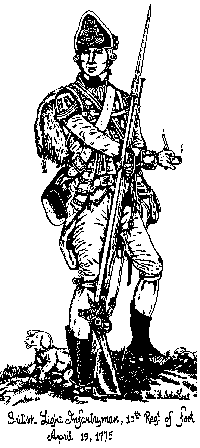
In keeping with the Editor's request sometime last year asking for complete pieces on 18th Century topics, and as part of my ongoing effort to chronicle most aspects of the Southern Campaign, here is a uniform guide to accompany the Order of Battle. (The Courier #66:)
As with all things, some assumptions were made since the record is incomplete and often contradictory. One thing to keep in mind is that the uniforms listed are for the Southern Campaign time frame. Often, especially with American units, different uniforms were worn by regiments at different times. One needs to realize that a unit was often clothed very differently in 1777 than in 1781. Again, this applies mostly to the Americans.
Some notes in the charts need elaboration on headgear, uniforms, etc. British light infantry wore a variety of hats, the most commonly known being the leather cap with a large straight peak in front. "Floppy" or slouch hats were also popular. British grenadiers wore the famous bearskin hat while the two fusilier regiments that served in the south wore a similar, albeit lower design. German grenadiers wore a metal "mitre" cap and their fusiliers wore a similar but shorter metal cap.
Of the seven French regiments at Yorktown, only the four (and Luzons Legion) that came with Rocheambeu had uniforms issued prior to the new regulations of 1779. That means that Luzons, the Royal Deux Ponts, Saintonge, Bourbonnois, and Soissonois regiments still had chasseurs that wore a variety of light infantry caps and grenadiers that wore bearskin hats. The three regiments that De Grasse transported, the Agenois, Gatenois, and Touraine, were post-1779 uniform regulations meaning that the chasseurs and grenadiers wore tricorns like everybody else. Their status was distinguished by shoulder straps and red pompoms on the hats for the grenadiers.
For the most part, musicians of most units wore the reversed colors of their regiments although there were a few exceptions for the British. "Royal" British regiments musicians wore red coats faced blue. French regimental musicians wore blue coats faced with red and lots of white braided trim. For that matter, most British musicians were covered in braided trim. German units did not reverse colors although the braided trim was present.
There are numerous books out on uniforms. Unfortunately, no single book provides everything you need for the period. However, four stand out:
1. Charles Lefferts, Uniforms of the American, British, French, and German Armies of the War of the American Revolution. Leffert's work is widely used although in many cases has been superceded by later scholarly work. It should not be used by itself.
2. John Mollo & Malcolm McGregor, Uniforms of the American
Revolution.  Probably the most widely recognized book of the period. The
color plates are a real boon to the painter. This book picks up where
Lefferts left off. Unfortunately, many of the uniforms for regiments it
lists drastically changed after the time mentioned by the authors and they
do not describe the later uniform.
Probably the most widely recognized book of the period. The
color plates are a real boon to the painter. This book picks up where
Lefferts left off. Unfortunately, many of the uniforms for regiments it
lists drastically changed after the time mentioned by the authors and they
do not describe the later uniform.
3. Phillip Katcher, Uniforms of the Continental Army. Katcher has written a ream of material over the years and this is probably his best work on the American forces. Combined with the Mollo book, you can pretty much piece together how most American units were uniformed. The only drawback is that he does not mention any of the State Line units.
4. Phillip Katcher, Encyclopedia of British, Provincial, and German Army units 1775-1783. An excellent work on the British and their forces. Again, if used in conjunction with the other books, the wargamer can get a reasonably accurate picture of the British forces. It is especially good with Loyalist units.
As for figures, the AWI is blessed with 20 years of accumulated work. Most has been in 25mm which is the way I feel the period should be played. The age of linear warfare combined with small army sizes make the AWI a good excuse to get into 25mm. I can see the need for 15mm when gaming areas like the Civil War or Napoleonics but when you might have only 75-100 figures on a side, 25mm makes a much better presentation.
Of course defining 25mm is always an interesting topic. I use figures ranging from my old plastic Airfix 20mm guys (when you are just 13 years old, its all you can afford-the irony here is that back when all I could afford was Airfix, a 25mm figure cost an exorbirant 25 cents a figure) up to Front Ranks 30mm "25mm" line. No matter, it all seems to work. Other manufacturers with extensive lines include Redoubt, Minifigs, Musket Miinatures, Falcon, Hinchcliffe, Wargames Foundry and Garrison. You can also still find Custom Cast figures at flea markets and I think there is a company in Oklahoma that makes them.
Between these, you can pretty much piece together even the most esoteric AWI unit.
British Forces Uniform Guide
American Forces Uniform Guide
Related
-
The Southern Campaign of the American Revolution: Part II
Pour Le Merit: Rules for the AWI
What Happened to AWI Commanders
Back to Table of Contents -- Courier #68
To Courier List of Issues
To MagWeb Master Magazine List
© Copyright 1995 by The Courier Publishing Company.
This article appears in MagWeb (Magazine Web) on the Internet World Wide Web.
Other military history articles and gaming articles are available at http://www.magweb.com